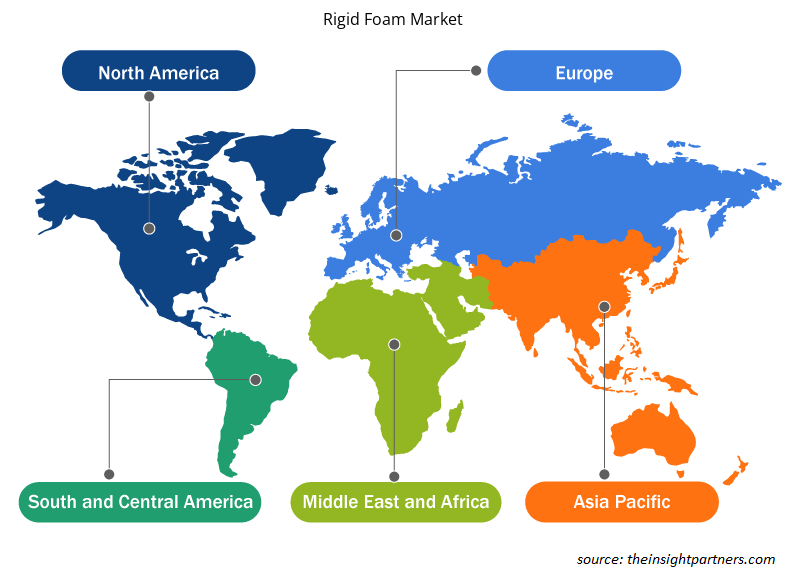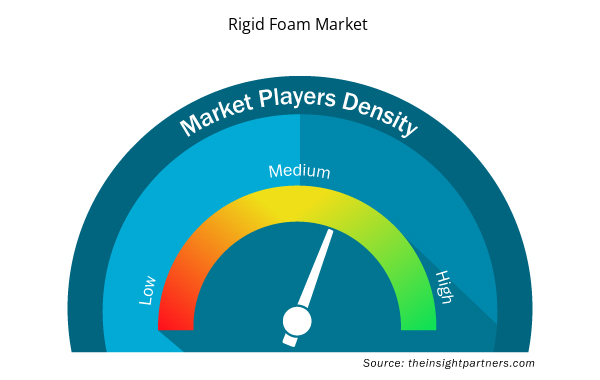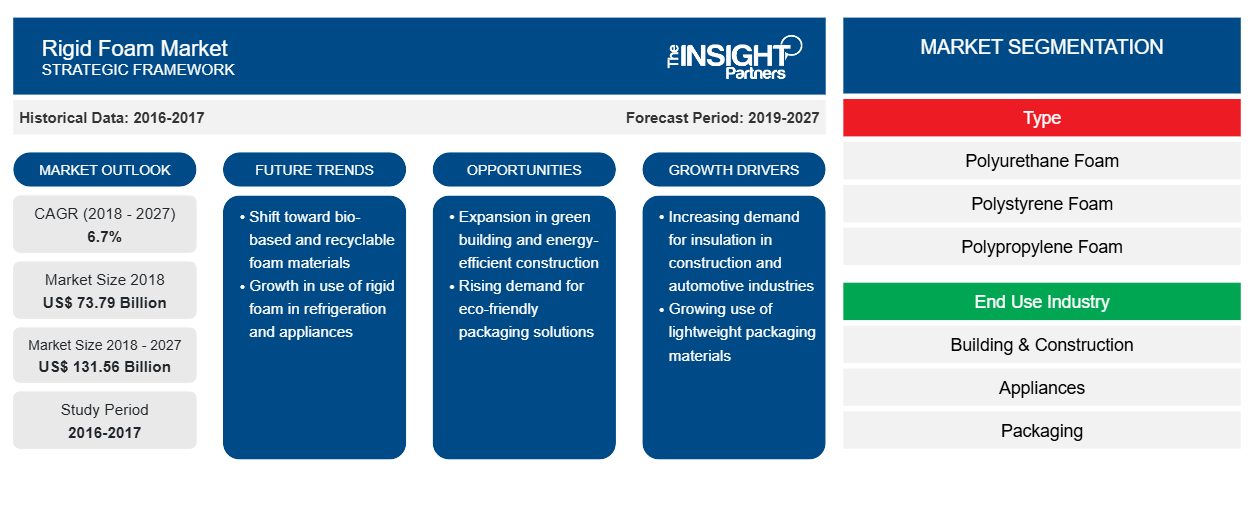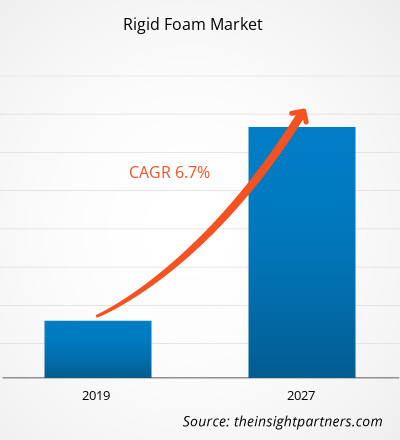[Rapporto di ricerca] Il mercato della schiuma rigida ha rappresentato 73.786,7 milioni di dollari nel 2018 e si prevede che crescerà a un CAGR del 6,7% durante il periodo di previsione 2019-2027, fino a raggiungere 131.558,9 milioni di dollari entro il 2027.
Le schiume rigide sono note per possedere varie proprietà come impermeabilità, antistatiche, antivibrazioni e antiscivolo, che le rendono un materiale ideale per essere utilizzato in molti settori industriali e edili. La schiuma rigida protegge le superfici in calcestruzzo su cui viene applicata ed è responsabile dell'estensione della durata dei pavimenti in calcestruzzo sottostanti. Sono inerti a oli, detergenti e detergenti, fluidi di trasmissione, acqua, grandine, neve e sostanze chimiche corrosive. La schiuma rigida viene anche utilizzata per migliorare l'aspetto estetico del pavimento. Sono disponibili in diversi colori, tonalità e texture. Pigmenti metallici e scaglie di colore vinilico vengono aggiunti ai sistemi di schiuma rigida per produrre superfici con colori iridescenti. Si prevede che l'aspetto estetico della schiuma rigida colorata guiderà il mercato della schiuma rigida e viene sempre più utilizzata nei nuovi progetti abitativi e nella ristrutturazione di vecchie case.
Nel 2018, l'APAC deteneva la quota maggiore del mercato globale delle schiume rigide . Questa crescita del mercato nell'APAC è attribuibile principalmente alla presenza di importanti produttori di schiume rigide nella regione. Inoltre, si prevede che le crescenti attività di produzione di schiume rigide alimenteranno la crescita del mercato nel periodo 2019-2027. Nell'area Asia-Pacifico, la Cina ha rappresentato la quota maggiore di schiume rigide in termini di fatturato generato.
Personalizza questo report in base alle tue esigenze
Riceverai la personalizzazione gratuita di qualsiasi report, comprese parti di questo report, o analisi a livello nazionale, pacchetto dati Excel, oltre a usufruire di grandi offerte e sconti per start-up e università
- Scopri le principali tendenze di mercato in questo rapporto.Questo campione GRATUITO includerà analisi di dati che spaziano dalle tendenze di mercato alle stime e alle previsioni.
Approfondimenti di mercato
Adozione di nuove schiume di poli(lattide-uretano-isocianurato) basate su scarti di bio-polilattide
Rapidi progressi nel campo dei polimeri sono stati osservati con l'aumento della produzione di materie plastiche e polimeri negli ultimi anni. Si prevede che una tendenza al rialzo nell'industria dei polimeri genererà un'elevata percentuale di rifiuti di polimeri. Inoltre, sono state create nuove regole e normative sulla scia della protezione ambientale, che stanno spingendo scienziati e imprenditori a cercare soluzioni alternative per gestire e trattare i rifiuti di plastica o l'adozione di materie plastiche biodegradabili che potrebbero decomporsi nell'ambiente naturale. Tra i diversi tipi di materie plastiche biodegradabili prodotte in tutto il mondo, il polilattide (PLA) è ritenuto una delle forme preferite di bioplastiche. I rifiuti generati da queste materie plastiche possono essere facilmente trasformati in un prodotto di valore completo come le schiume rigide di poliuretano-poliisocianurato (RPU/PIR). Tali schiume prodotte da polilattide biodegradabile sono trattate come soluzioni sostenibili. Secondo uno studio presentato da Europe PMC, il polilattide può sostituire parzialmente il poliolo petrolchimico nella formulazione del poliisocianurato. Inoltre, le schiume PIR ottenute possiedono diverse caratteristiche come densità apparente minima, fragilità e capacità di assorbimento dell'acqua. Pertanto, l'uso di poliolo PLA composto da rifiuti di plastica può essere un'ottima alternativa ai polioli petrolchimici. Tali sviluppi aiutano a gestire le scarse risorse e aiutano nell'utilizzo efficace dei rifiuti. Inoltre, i prodotti realizzati da tale biomateriale sono considerati soluzioni ecocompatibili.
Tipo Informazioni
In base al tipo, il mercato della schiuma rigida è biforcato in base a schiuma di poliuretano, schiuma di polistirene, schiuma di polipropilene, schiuma di polietilene, schiuma di cloruro di polivinile e altri. Il segmento della schiuma di poliuretano ha dominato il mercato globale della schiuma rigida. La schiuma di poliuretano rigida è ampiamente utilizzata nell'industria della refrigerazione, dell'edilizia e dell'imballaggio grazie alle sue superiori proprietà isolanti e alla buona stabilità dimensionale.
Approfondimenti sul settore dell'uso finale
Il mercato della schiuma rigida è diviso in base all'uso finale in edilizia e costruzioni, elettrodomestici, imballaggi, automotive e altri. Il segmento dell'edilizia e delle costruzioni ha rappresentato la quota maggiore nel mercato globale della schiuma rigida. Il loro utilizzo nella costruzione di case ed edifici riduce l'energia necessaria per riscaldare e raffreddare gli spazi interni di edifici, negozi e uffici. Si prevede che il crescente consumo di schiume rigide da parte del settore dell'edilizia e delle costruzioni sosterrà la crescita del mercato globale della schiuma rigida durante il periodo di previsione.
Diverse strategie sono comunemente adottate dalle aziende per espandere la propria presenza in tutto il mondo. Huntsman Corporation., Covestro, BASF SE. sono tra i principali attori del mercato globale della schiuma rigida che implementano queste strategie per ampliare la base clienti e ottenere una quota significativa, il che, a sua volta, consente loro di mantenere il proprio marchio a livello globale.
Approfondimenti regionali sul mercato della schiuma rigida
Le tendenze regionali e i fattori che influenzano il Rigid Foam Market durante il periodo di previsione sono stati ampiamente spiegati dagli analisti di Insight Partners. Questa sezione discute anche i segmenti e la geografia del Rigid Foam Market in Nord America, Europa, Asia Pacifico, Medio Oriente e Africa e Sud e Centro America.

- Ottieni i dati specifici regionali per il mercato della schiuma rigida
Ambito del rapporto sul mercato della schiuma rigida
| Attributo del report | Dettagli |
|---|---|
| Dimensioni del mercato nel 2018 | 73,79 miliardi di dollari USA |
| Dimensioni del mercato entro il 2027 | 131,56 miliardi di dollari USA |
| CAGR globale (2018 - 2027) | 6,7% |
| Dati storici | 2016-2017 |
| Periodo di previsione | 2019-2027 |
| Segmenti coperti | Per tipo
|
| Regioni e Paesi coperti | America del Nord
|
| Leader di mercato e profili aziendali chiave |
|
Densità dei player del mercato della schiuma rigida: comprendere il suo impatto sulle dinamiche aziendali
Il mercato del Rigid Foam Market sta crescendo rapidamente, spinto dalla crescente domanda degli utenti finali dovuta a fattori quali l'evoluzione delle preferenze dei consumatori, i progressi tecnologici e una maggiore consapevolezza dei vantaggi del prodotto. Con l'aumento della domanda, le aziende stanno ampliando le loro offerte, innovando per soddisfare le esigenze dei consumatori e capitalizzando sulle tendenze emergenti, il che alimenta ulteriormente la crescita del mercato.
La densità degli operatori di mercato si riferisce alla distribuzione di aziende o società che operano in un particolare mercato o settore. Indica quanti concorrenti (operatori di mercato) sono presenti in un dato spazio di mercato in relazione alle sue dimensioni o al valore di mercato totale.
Le principali aziende che operano nel mercato della schiuma rigida sono:
- ARMACELL INTERNATIONAL HOLDING GMBH
- BOREALIS AG
- SOCIETÀ DI SAINT-GOBAIN SA
- Covestro AG
- Società chimica Dow
Disclaimer : le aziende elencate sopra non sono classificate secondo un ordine particolare.

- Ottieni una panoramica dei principali attori del mercato della schiuma rigida
Segnala i riflettori
- Le tendenze progressive del settore nel mercato della schiuma rigida aiutano gli operatori a sviluppare strategie efficaci a lungo termine
- Strategie di crescita aziendale adottate dai mercati sviluppati e in via di sviluppo
- Analisi quantitativa del mercato della schiuma rigida dal 2017 al 2027
- Stima della domanda di schiuma rigida in vari settori
- Analisi PEST per illustrare l'efficacia degli acquirenti e dei fornitori che operano nel settore per prevedere la crescita del mercato
- Sviluppi recenti per comprendere lo scenario competitivo del mercato e la domanda di schiuma rigida
- Tendenze e prospettive del mercato, insieme ai fattori che guidano e frenano la crescita del mercato della schiuma rigida
- Comprensione delle strategie che sostengono l'interesse commerciale per quanto riguarda la crescita del mercato della schiuma rigida, che facilita il processo decisionale per le dimensioni del mercato della schiuma rigida degli stakeholder in vari nodi di mercato
- Panoramica dettagliata e segmentazione del mercato della schiuma rigida, nonché delle sue dinamiche nel settore
Mercato globale della schiuma rigida – per tipo
- Schiuma di poliuretano
- Polistirolo espanso
- Schiuma di polipropilene
- Schiuma di polietilene
- Schiuma di cloruro di polivinile
- Altri
Mercato globale della schiuma rigida – per settore di utilizzo finale
- Edilizia e costruzioni
- Elettrodomestici
- Confezione
- Automobilistico
- Altri
Profili aziendali
- Saint Gobain
- Società chimica Dow
- BASF SE
- Borealis AG
- Società chimica Sekisui, Ltd.
- Covestro AG
- Armacell International SA
- Huntsman International LLC
- JSP
- Zotefoams Plc
- Analisi storica (2 anni), anno base, previsione (7 anni) con CAGR
- Analisi PEST e SWOT
- Valore/volume delle dimensioni del mercato - Globale, regionale, nazionale
- Industria e panorama competitivo
- Set di dati Excel



Report Coverage
Revenue forecast, Company Analysis, Industry landscape, Growth factors, and Trends

Segment Covered
This text is related
to segments covered.

Regional Scope
North America, Europe, Asia Pacific, Middle East & Africa, South & Central America

Country Scope
This text is related
to country scope.
Domande frequenti
Growing demand for rigid foam in the building and construction industry is one of the factors that has contributed to favor the rigid foam market all over the globe. Rigid foam sheaths are used as insulation materials to control indoor temperature and thereby reduce the building’s energy consumption. Rigid foams made from expanded polystyrene (EPS), extruded polystyrene (XPS), and polyisocyanurate are valued for their thermal insulation properties and offer durability and moisture control.
The Asia Pacific region led the rigid foam market with a market share of 44.4% in 2018. The continuous economic growth in developed and developing countries like India and China, coupled with the presence of huge disposable incomes with individuals in countries like Japan and Australia, has facilitated the rapid growth of the automotive industry in this region. The Asia Pacific is one of the world’s rapidly growing automotive markets, with China accounting for maximum car production. The rapid growth in industrialization and urbanization in the economy is positively impacting the growth of the rigid market in the APAC region. Moreover, the market for rigid foam is expected to rise with the growth of end-use industries.
The leading type of rigid foam was the polyurethane foam that was noted to account for a CAGR of 6.6%. Rigid polyurethane foam (PUF) is regarded as an efficient insulation material that is used to save energy. They have one of the highest thermal resistance value per inch of all commercially available insulating materials. The growing demand for polyurethane foam can be attributed to the rise in the consumption of insulation materials used in the building and construction sector and the HVAC and refrigeration industries.
Trends and growth analysis reports related to Chemicals and Materials : READ MORE..
The List of Companies
- ARMACELL INTERNATIONAL HOLDING GMBH
- BOREALIS AG
- COMPAGNIE DE SAINT-GOBAIN S.A.
- Covestro AG
- Dow Chemical Corporation
- Huntsman International LLC
- JSP
- BASF SE
- SEKISUI CHEMICAL CO., LTD.
- ZoteFoams Plc
The Insight Partners performs research in 4 major stages: Data Collection & Secondary Research, Primary Research, Data Analysis and Data Triangulation & Final Review.
- Data Collection and Secondary Research:
As a market research and consulting firm operating from a decade, we have published and advised several client across the globe. First step for any study will start with an assessment of currently available data and insights from existing reports. Further, historical and current market information is collected from Investor Presentations, Annual Reports, SEC Filings, etc., and other information related to company’s performance and market positioning are gathered from Paid Databases (Factiva, Hoovers, and Reuters) and various other publications available in public domain.
Several associations trade associates, technical forums, institutes, societies and organization are accessed to gain technical as well as market related insights through their publications such as research papers, blogs and press releases related to the studies are referred to get cues about the market. Further, white papers, journals, magazines, and other news articles published in last 3 years are scrutinized and analyzed to understand the current market trends.
- Primary Research:
The primarily interview analysis comprise of data obtained from industry participants interview and answers to survey questions gathered by in-house primary team.
For primary research, interviews are conducted with industry experts/CEOs/Marketing Managers/VPs/Subject Matter Experts from both demand and supply side to get a 360-degree view of the market. The primary team conducts several interviews based on the complexity of the markets to understand the various market trends and dynamics which makes research more credible and precise.
A typical research interview fulfils the following functions:
- Provides first-hand information on the market size, market trends, growth trends, competitive landscape, and outlook
- Validates and strengthens in-house secondary research findings
- Develops the analysis team’s expertise and market understanding
Primary research involves email interactions and telephone interviews for each market, category, segment, and sub-segment across geographies. The participants who typically take part in such a process include, but are not limited to:
- Industry participants: VPs, business development managers, market intelligence managers and national sales managers
- Outside experts: Valuation experts, research analysts and key opinion leaders specializing in the electronics and semiconductor industry.
Below is the breakup of our primary respondents by company, designation, and region:

Once we receive the confirmation from primary research sources or primary respondents, we finalize the base year market estimation and forecast the data as per the macroeconomic and microeconomic factors assessed during data collection.
- Data Analysis:
Once data is validated through both secondary as well as primary respondents, we finalize the market estimations by hypothesis formulation and factor analysis at regional and country level.
- Macro-Economic Factor Analysis:
We analyse macroeconomic indicators such the gross domestic product (GDP), increase in the demand for goods and services across industries, technological advancement, regional economic growth, governmental policies, the influence of COVID-19, PEST analysis, and other aspects. This analysis aids in setting benchmarks for various nations/regions and approximating market splits. Additionally, the general trend of the aforementioned components aid in determining the market's development possibilities.
- Country Level Data:
Various factors that are especially aligned to the country are taken into account to determine the market size for a certain area and country, including the presence of vendors, such as headquarters and offices, the country's GDP, demand patterns, and industry growth. To comprehend the market dynamics for the nation, a number of growth variables, inhibitors, application areas, and current market trends are researched. The aforementioned elements aid in determining the country's overall market's growth potential.
- Company Profile:
The “Table of Contents” is formulated by listing and analyzing more than 25 - 30 companies operating in the market ecosystem across geographies. However, we profile only 10 companies as a standard practice in our syndicate reports. These 10 companies comprise leading, emerging, and regional players. Nonetheless, our analysis is not restricted to the 10 listed companies, we also analyze other companies present in the market to develop a holistic view and understand the prevailing trends. The “Company Profiles” section in the report covers key facts, business description, products & services, financial information, SWOT analysis, and key developments. The financial information presented is extracted from the annual reports and official documents of the publicly listed companies. Upon collecting the information for the sections of respective companies, we verify them via various primary sources and then compile the data in respective company profiles. The company level information helps us in deriving the base number as well as in forecasting the market size.
- Developing Base Number:
Aggregation of sales statistics (2020-2022) and macro-economic factor, and other secondary and primary research insights are utilized to arrive at base number and related market shares for 2022. The data gaps are identified in this step and relevant market data is analyzed, collected from paid primary interviews or databases. On finalizing the base year market size, forecasts are developed on the basis of macro-economic, industry and market growth factors and company level analysis.
- Data Triangulation and Final Review:
The market findings and base year market size calculations are validated from supply as well as demand side. Demand side validations are based on macro-economic factor analysis and benchmarks for respective regions and countries. In case of supply side validations, revenues of major companies are estimated (in case not available) based on industry benchmark, approximate number of employees, product portfolio, and primary interviews revenues are gathered. Further revenue from target product/service segment is assessed to avoid overshooting of market statistics. In case of heavy deviations between supply and demand side values, all thes steps are repeated to achieve synchronization.
We follow an iterative model, wherein we share our research findings with Subject Matter Experts (SME’s) and Key Opinion Leaders (KOLs) until consensus view of the market is not formulated – this model negates any drastic deviation in the opinions of experts. Only validated and universally acceptable research findings are quoted in our reports.
We have important check points that we use to validate our research findings – which we call – data triangulation, where we validate the information, we generate from secondary sources with primary interviews and then we re-validate with our internal data bases and Subject matter experts. This comprehensive model enables us to deliver high quality, reliable data in shortest possible time.


 Ottieni un campione gratuito per questo repot
Ottieni un campione gratuito per questo repot